If your Wi-Fi isn't giving you excellent coverage with consistent and reliable speeds, you're missing out. Even one of the best Wi-Fi routers can struggle on its own if you have thick walls or a big house. Mesh systems can work around these obstacles with multiple nodes instead of having to use brute force in every direction.
A mesh Wi-Fi system works by connecting multiple routers, or nodes, wirelessly to create a blanket of coverage around your home. Each node is linked with a high-speed wireless connection; that way, your wireless devices can connect to the nearest node, allowing the mesh to do the heavy lifting. Whether you just need enough speed for browsing and streaming or have more demanding requirements like finding a router for gaming, there's a mesh for you.
Get whole-home coverage with the best mesh Wi-Fi routers
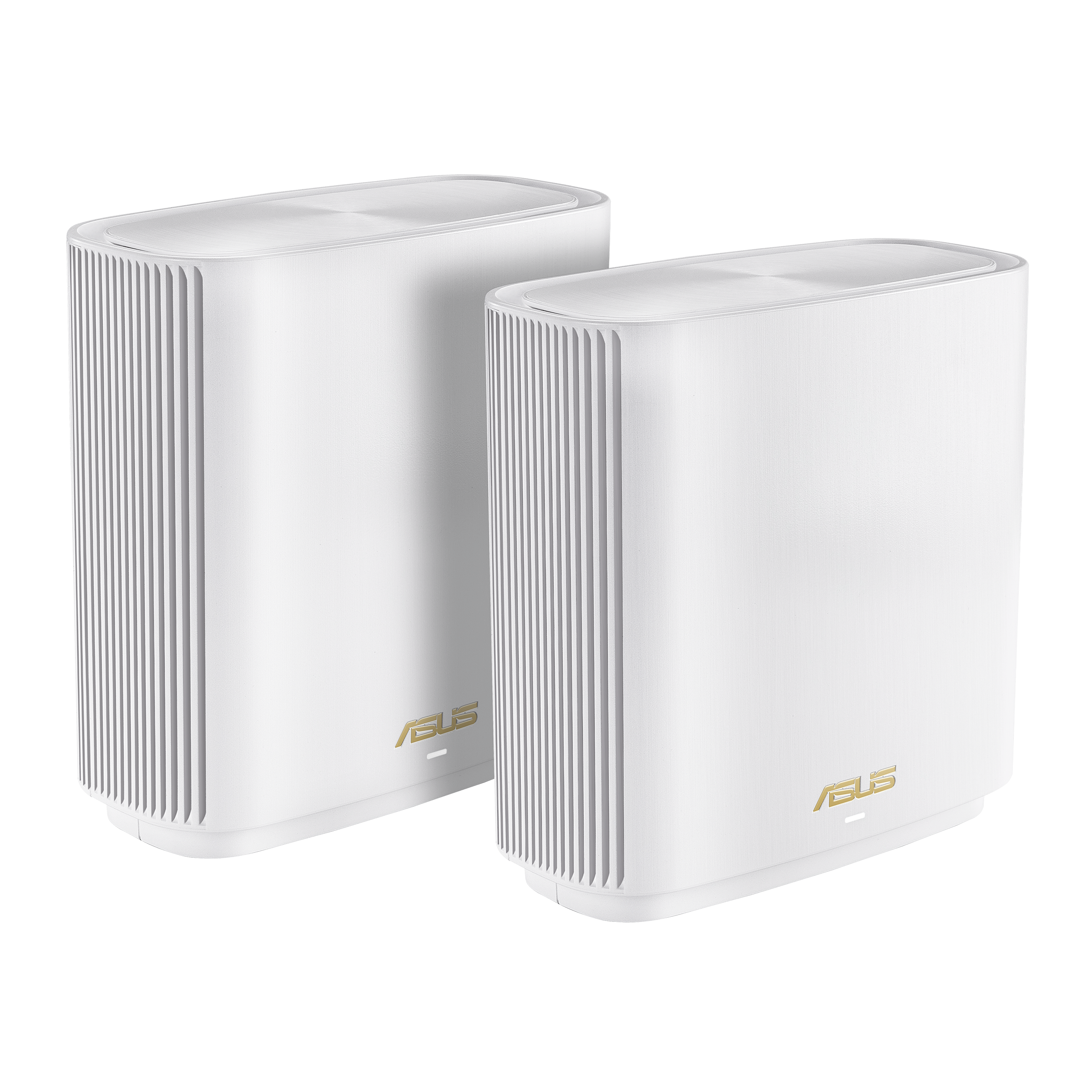
ASUS ZenWiFi XT9
Fast 5GHz speeds in a mesh
The Asus ZenWiFi XT9 is a tri-band mesh kit with up to AX7800 speeds. This allows for fast connections on both 5GHz bands, so you don't have to choose between a fast backhaul and fast device connections. There's a 2.5Gbps Ethernet port for multi-gig connections, and you get Asus' strong AiProtection Pro package included for free.
- Fast AX7800 tri-band connection
- AiProtection Pro is included for free
- Easy mesh expansion with AiMesh compatibility
- Only one 2.5Gbps Ethernet per node
- Nodes are large
The ZenWiFi XT9 is a quick tri-band Wi-Fi 6 mesh router with an AX7800 connection and multi-gig Ethernet. The connection breaks down to 574Mbps at 2.4GHz, 2402Mbps at 5GHz-1, and 4804Mbps at 5GHz-2. Compared to its older brother, the XT8, you get double the speed on the lower 5GHz band. This is helpful since you'll need to use some of your 5GHz capacity to link the mesh nodes, and having two fast bands means you won't need to share those connections. You also get support for 160MHz connections, plus Asus' software allows you to pick which band is used to link your mesh.
Compared to some of the tiny mesh routers from Eero or TP-Link, the XT9 nodes are quite large, but they also offer strong coverage and solid wired connections. There's a 2.5Gbps Ethernet port for incoming connections, so you can hook your ZenWiFi mesh into your existing high-speed wired network or connect directly to your modem. There's also a USB-A 3.2 port which can be used for storage or with a backup internet source.
Asus includes AiProtection Pro for free with this model, including security software and robust parental controls. The parental controls allow you to create profiles, set schedules, and block content for each member of the family individually. With plenty of 5GHz capacity and a fast backhaul, the ZenWiFi XT9 is a powerful mesh system that will work in most homes.
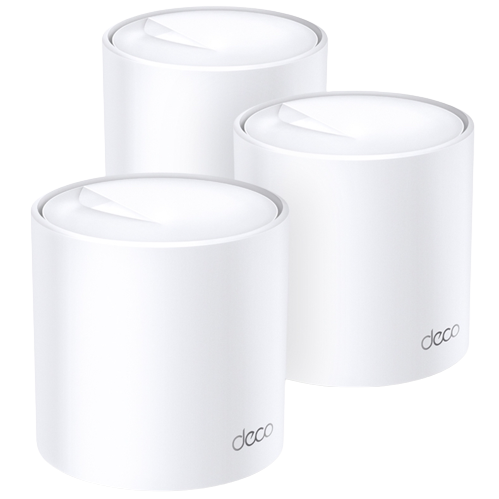
TP-Link Deco X20
Compact Wi-Fi 6 mesh
The TP-Link Deco X25 is a simple Wi-Fi 6 mesh with AX1800 speeds that are suitable for internet connection up to around 500Mbps. A pack of three covers up to 5,800 square feet and should be plenty for most homes.
- Coverage
- 5,800 square feet
- Bands
- 2.4GHz, 5GHz
- Speed
- AX1800
- Wi-Fi Protocols
- Wi-Fi 6
- Security
- WAP-3
- App requirements
- Deco
- Ports
- 2x 1Gbps per node
- Solid AX1800 dual-band speeds
- Easy mesh expansion with other Deco nodes
- Decent free parental controls with HomeShield
- Not fast enough for gigabit connections
- Full HomeShield package requires a paid subscription
The TP-Link Deco X20 has been around for a while now with a middle-of-the-road AX1800 dual-band connection, but it's still an excellent value for the amount of coverage you get. Its connection breaks down to 1201Mbps at 5GHz and 574Mbps at 2.4GHz, but keep in mind that part of that capacity needs to be used to link the mesh nodes. As a result, your real-world speeds will be around 500Mbps with this kit, which is still plenty for most applications, including 4K streaming. Naturally, it supports modern Wi-Fi tech like beamforming and MU-MIMO, which can help keep speeds high when coverage starts getting weak or there is a lot of wireless congestion in your area.
A three-node kit can cover up to 5,800 square feet, which is plenty for most homes. If you feel you need more, you can add another Deco, even a different model, to the mesh, though you should put your fastest hardware at the center of the mesh. Each node in the Deco X20 kit has two gigabit Ethernet ports on the back. One port on your primary Deco will be used for the incoming connection, and the other can be used for a wired device, or as a wired backhaul connecting one of your nodes. While the ports are gigabit speed, the connected device will still be limited by the speed of the mesh connection on the remote nodes. Still, it's nice to have the option for a wired connection, especially if you place one of the nodes in a home office that needs a reliable connection.
TP-Link includes its HomeShield software on this model, which provides security settings for free with the option to upgrade for more features like web protection, intrusion detection, and IoT device protection. Basic parental controls are also included with profiles, website blocking, and content filtering. If you want more features like time limites and rewards, you can subscribe to Advanced Parental Controls as well.
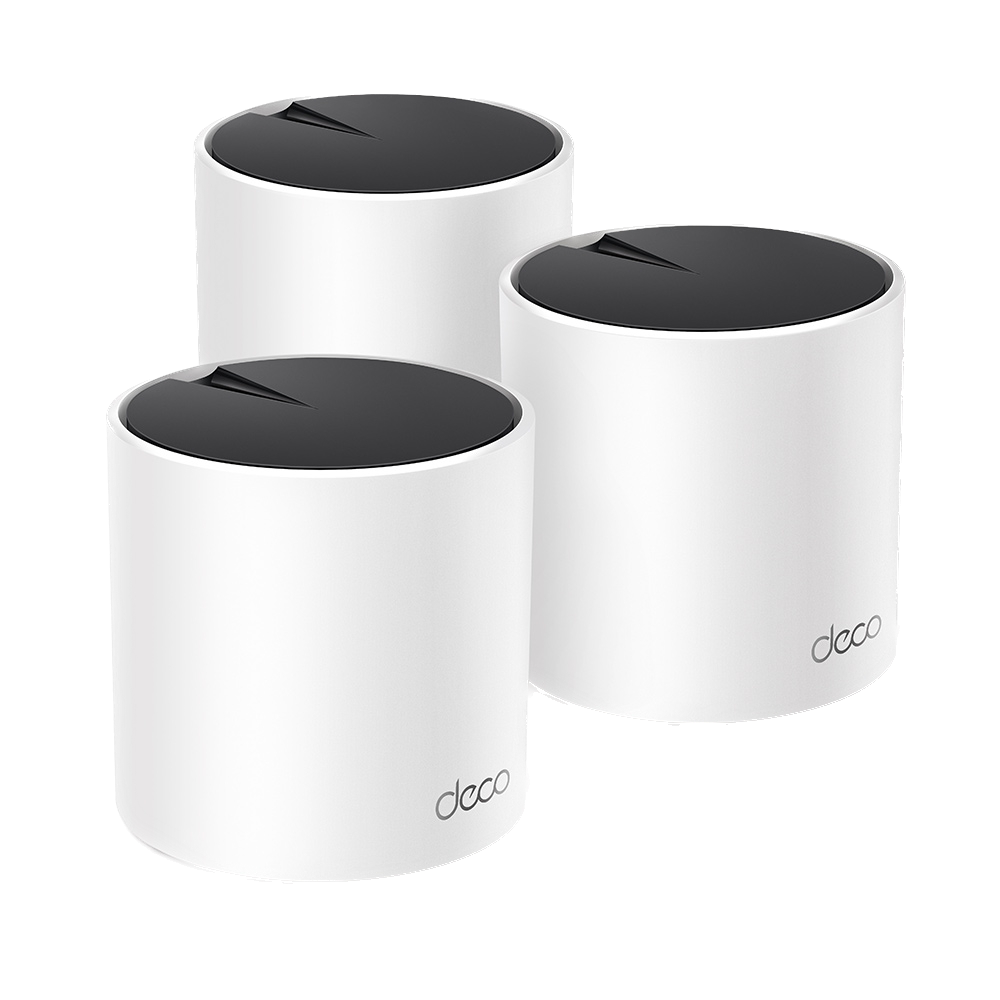
TP-Link Deco X55
Fast 5GHz performance
The TP-Link Deco X55 is a big step up from the above Deco X25 in terms of pure speed with its AX3000 connection. This doubles the speed of the 5GHz band with support for 160MHz connections, getting you much closer to gigabit speeds in your home. With up to 6,500 square feet of coverage from three nodes, this kit will blanket most homes with ease.
- Quick dual-band AX3000 Wi-Fi 6 connection
- Compact size makes them easy to hide
- Easy mesh expansion with other Deco nodes
- Only gigabit Ethernet speeds
- Full HomeShield subscriptions costs extra
The TP-Link Deco X55 with its AX3000 connection represents a big step-up for Wi-Fi 6 mesh kits thanks to support for 160MHz connections. This enables 5GHz speeds up to 2402Mbps with another 574Mbps at 2.4GHz. This gives the system around double the headroom for 5GHz connections, including the connection that links the nodes, so you can get much closer to gigabit speeds on Wi-Fi. On the back, two gigabit Ethernet ports on each node make it easy to connect wired devices as well.
The mesh is set up in just a few minutes using the Deco app with step-by-step instructions, so even inexperienced users can get set up without needing to phone a friend. The app can also be used to see which devices are connected to your network, as well as parental controls to restrict the type of content certain devices can access with a set of filters. You can also see the strength of your network and add nodes to your mesh if you find you need a bit more coverage.
You can use any Deco node to expand your mesh, so you can mix and match to save money. For example, you can use a cheaper node, like an AX1800 model where speed isn't as important, such as in a garage. TP-Link even makes an outdoor Deco which could be perfect for someone with a big backyard.
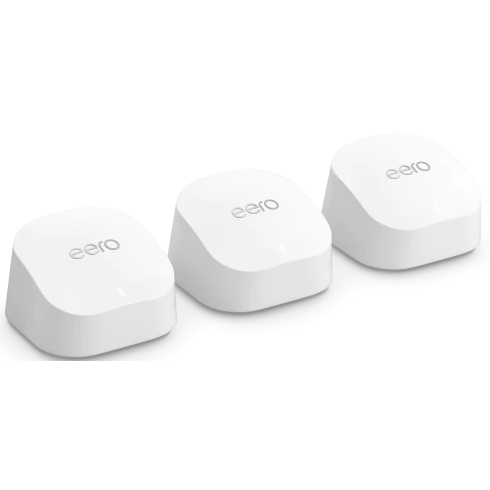
Eero 6+
One of the best Wi-Fi management apps in the business
With an AX3000 connection and support for 160MHz connection, Eero 6+ has all the power most people need with an app experience that's refreshingly easy to use whether it's your first time setting up Wi-Fi, or if you're a veteran. Eero also keeps its hardware up to date, including support for it's Eero Plus subscription that makes network management simple.
- Quick AX3000 connection with 160MHz support
- Mesh expansion with any other Eero model supported
- Excellent setup experience with the app
- Not many advanced settings available
- An online account is required
While all Eero routers share the same software experience, the Eero 6+ offers plenty of speed for the vast majority of Wi-Fi users. Its AX3000 connection breaks down to 2402Mbps at 5GHz and 574Mbps at 2.4GHz. Since this wireless connection is used to link the mesh nodes together, the actual speed available to your device can vary, but with a full 2402Mbps on the 5GHz band, you can still get quite close to gigabit speeds with a good signal.
Eero 6+ nodes are small at under four inches wide and under three inches tall. Despite the compact size, three Eero 6+ nodes can cover up to 4,500 square feet, and will be all most people need. If you find that coverage isn't quite good enough, you can add any model Eero to the mesh for better coverage. Just keep in mind that if you add a slower Eero to the mix, devices connected to it may experience lower speeds. The same can be said of Eero built-in devices like Amazon Echo devices.
When you buy an Eero system, download and install the Eero app to your phone for setup. You can follow the on-screen instruction to get your network set up with the Wi-Fi name and password of your choosing. You'll also be notified of any software updates that need to be applied to your Eero nodes, so you can be sure you're running the most secure and stable software. Eero only offers basic Wi-Fi settings and doesn't allow you to split your network by bands, but you can still manage most settings average users are after.
You can also sign up for Eero Plus, which offers some security enhancements with products like Malwarebytes, ad blocking, a password manager, and even a VPN. It also comes with internet backup that allows you to use your mobile hotspot connection if your primary internet goes out, offers content filtering, and most importantly VIP support if you have any questions. Eero Plus costs $9.99 per month or $99 per year.
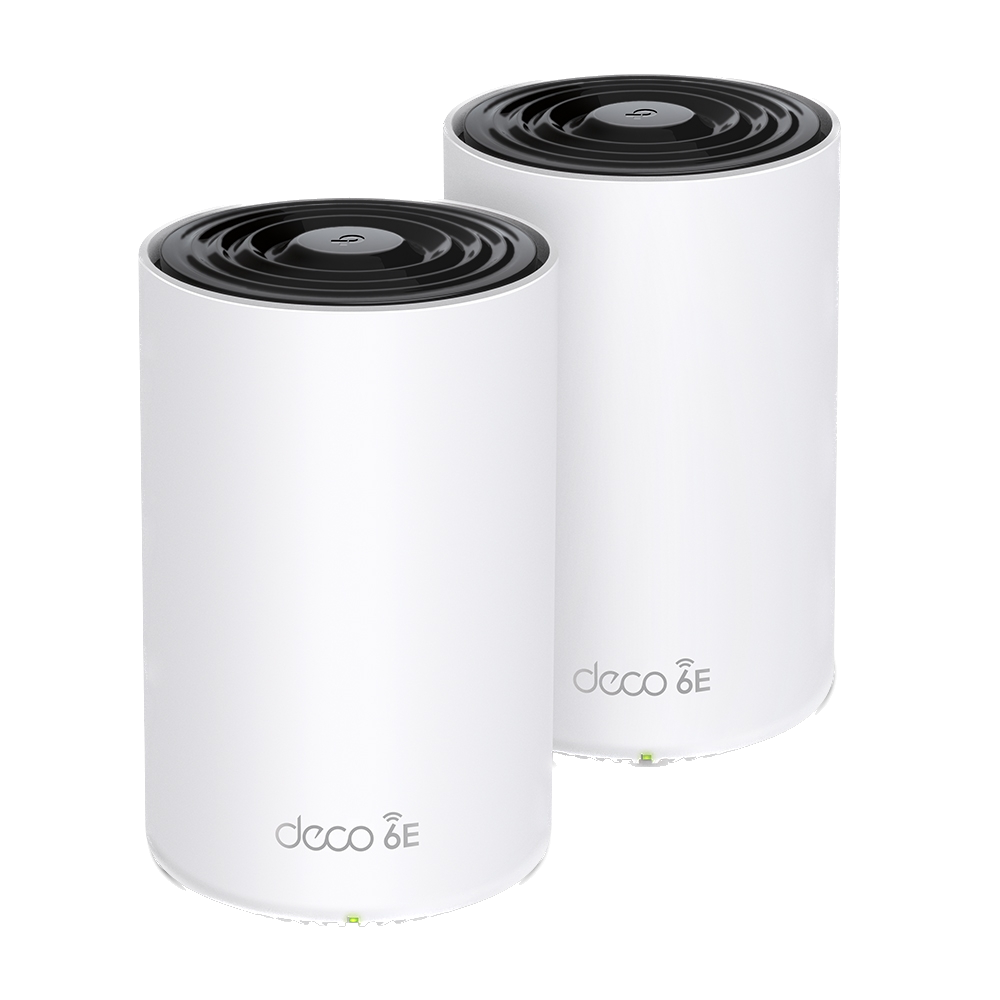
TP-Link Deco XE75
Avoid wireless congestion with 6GHz Wi-Fi
The TP-Link Deco XE75 is a mid-range Wi-Fi 6E mesh Wi-Fi kit with an AXE5400 tri-band connection. This router has 574Mbps available at 2.4GHz, 2402Mbps at 5GHz, and another 2402Mbps at 6GHz, allowing for fast mesh speeds, even in a heavily congested building.
- Fast 6GHz backhaul
- Support for 160MHz connections at 5GHZ and 6GHz
- Inexpensive for Wi-Fi 6E
- No multi-gig Ethernet
The TP-Link Deco XE75 cuts all the right corners to emerge as one of the best-value Wi-Fi 6E mesh systems. It has an AXE5400 connection which breaks down to 574Mbps at 2.4GHz, 2402Mbps at 5GHz, and 2402Mbps at 6GHz. This has been a reasonably popular configuration for mid-range Wi-Fi 6E mesh systems like Eero Pro 6E, Nest Wi-Fi Pro, Motorola Q16, and Wyze Mesh Wi-Fi Pro for a good reason. It offers full 160MHz speeds for both 5GHz and 6GHz devices, so you can make the most of your current and next-generation devices.
Around the back are three gigabit Ethernet ports, one for your incoming internet connection and the other two for wired devices. This model has no multi-gigabit Ethernet, but you could step up to the Deco XE75 Pro if that's important to you. TP-Link estimates up to 5,500 square feet of coverage for a two-pack, which should be enough for most homes. If you find you need a bit more coverage, you can expand with more Deco XE75 units or any of TP-Link's other Deco routers. If you have a multi-gig connection and a large home, you could even get an XE75 Pro as your main router with base XE75 nodes for expansion.
When it comes to software, setup is easy with the Deco app. In just a few minutes, you can be up and running with both nodes online. Once in the app, you'll have access to basic Wi-Fi settings and can even create a separate SSID for 6GHz, so you can force your Wi-Fi 6E devices to use the latest tech. This is handy, as these devices will often pick 5GHz connections on their own due to the higher perceived signal strength.
TP-Link uses its HomeShield software for security, QoS, and parental controls. Parents can create profiles for each family member and attach devices to each individual profile to filter inappropriate content from younger users without affecting the rest.
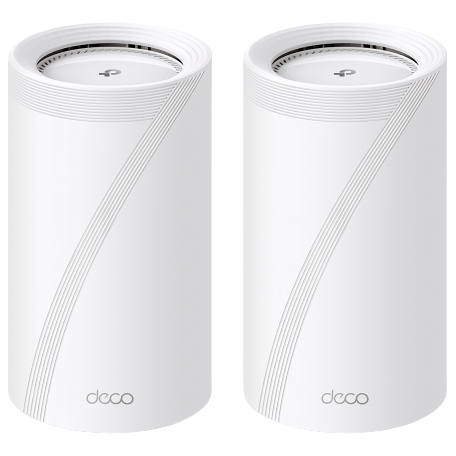
TP-Link Deco BE85
Blazing-fast 6GHz speeds with full 5GHz support
The Deco BE85 from TP-Link is one of the first Wi-Fi 7 devices available, and it has a ton of power on tap. The BE22000 connection devotes most of its speed to the backhaul but still has plenty of 5GHz capacity for multi-gig connections. On the back are two 10Gbps Ethernet ports, one of which can be used with SFP+, and two 2.5Gbps Ethernet.
- Blazing-fast tri-band BE22000 Wi-Fi 7 connection.
- Dual 10Gbps Ethernet with SFP+
- Strong mesh compatibility with all other Decos
- Very expensive
- No access to advanced settings
- Gets quite warm
Wi-Fi 7 is, unsurprisingly, the next generation of Wi-Fi technology, following Wi-Fi 6, bringing with it some of the biggest speed improvements ever seen with Wi-Fi. With a BE22000 connection, the Deco BE85 from TP-Link is a mesh Wi-Fi system with an ultra-fast 6GHz backhaul. In other words, the link between the nodes uses the latest 320MHz 6GHz bands to create a multi-gig wireless connection, even through a couple of walls. One of the problems with a new generation of Wi-Fi is that many people won't have devices that fully support it for years to come. However, since this mesh can use the new spectrum for its backhaul, even your older devices can benefit from Wi-Fi 7 speeds.
The BE85 nodes are fairly large at over nine inches tall and five inches in diameter, but they're still easy to tuck away in a living room. They also look modern and clean with a matte white finish and simple molding. The top is used to exhaust heat; these nodes need ventilation, as they kick out a noticeable amount of heat. However, this is a worthy trade-off since each node comes equipped with two 2.5Gbps Ethernet ports, two 10Gbps ports, and a USB Type-A port. One of the 10Gbps ports can be used as Ethernet or SFP+, a standard commonly used with fiber optic cable, which allows for much longer cable runs than Ethernet.
You can still use TP-Link's simple and clean Deco software for setup and management. Unfortunately, though, TP-Link gave up most advanced settings in pursuit of ease of use, so you'll need to use the app on iOS or Android for full control. Even so, you get some solid parental controls for free with the option to upgrade to a more in-depth package. You can also sign up for HomeShield, which offers a few security options. Even if you stick to what's available for free, you're getting one of the easiest user interfaces for any mesh system with a quick and easy setup process to boot.
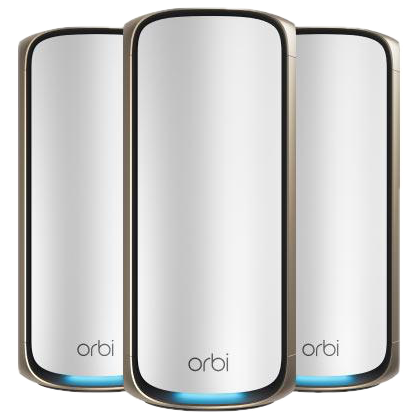
Netgear Orbi RBE973S
Ultra-fast quad-band mesh speeds
The Orbi RBE973S is one of the fastest Wi-Fi systems ever released with an absurdly fast BE27000 Wi-Fi 7 connection. With a dedicated backhaul linking the mesh with both 5GHz and 6GHz bands, this router has plenty of capacity for multi-gig wireless networking around the house.
- Blazing-fast BE27000 quad-band connection
- Up to 10,000 square feet of coverage with three nodes
- 10Gbps Ethernet on all nodes
- Very expensive
- Netgear Armor is fairly expensive after the free year
Netgear's latest Orbi is by far it's fastest and most capable model yet with 10Gbps wired networking on both the main router and satellite nodes. The BE27000 connection breaks down to 1147Mbps at 2.4GHz, 8647Mbps at 5GHz-1, 5765Mbps at 5GHz-2, and 11,530Mbps at 6GHz. The 5GHz-1 connection is a 240MHz wide dedicated backhaul linking the mesh nodes with extra capacity available on the 6GHz band. Having a dedicated backhaul keeps mesh performance high even when under heavy load, since it doesn't need to share bandwidth between the mesh connection and the connected devices.
On the back of the main Orbi 970 router, there is a 10Gbps Ethernet (10GbE) port for the internet connection, another 10GbE port for a device, and four 2.5Gbps Ethernet ports. The satellites each get a single 10GbE port, and two 2.5Gbps ports. It would have been nice to see another 10GbE port on the satellites like we saw on the Eero Max 7, another excellent Wi-Fi 7 mesh, but a single port still offers a lot of utility. That 10GbE port can also be used for a wired backhaul, so you can get the best speeds possible on your mesh if you've got 10Gbps-capable Ethernet in your home already. For most people, even the wireless backhaul will be overkill, but it's cool to see what's possible when Netgear doesn't hold anything back.
Mesh expansion is more limited than other brands with only additional Orbi 970 satellites working with the system. At these speeds, this makes sense since using an older Orbi node could significantly impact speeds. The Orbi app makes setup a breeze with step-by-step instructions, but will ask the customer to sign up for Netgear Armor and Advanced Parental Controls. At least Netgear Armor comes with a year for free, so you can get an idea if you like it before renewing.
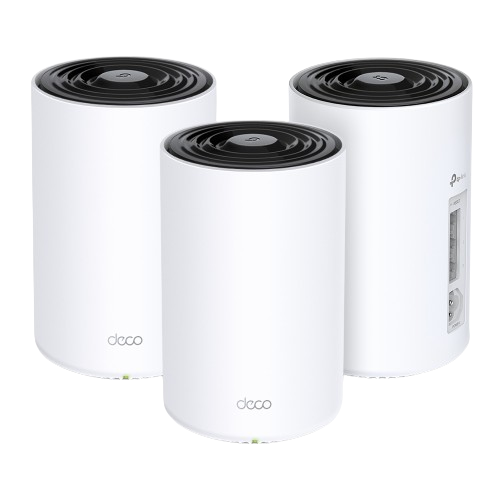
TP-Link Deco PX50
Wired backhaul without running any wires
If you want whole-home Wi-Fi but have thick walls that block wireless signals or just want a reliable wired backhaul without running any Ethernet, the Deco PX50 with powerline support could be the answer. It has three Ethernet ports per node and a quick AX3000 wireless connection.
- Fast AX3000 connection Wi-Fi
- Snappy 1.5Gbps powerline backhaul with G.hn
- Works with other Decos
- Powerline speeds can be inconsistent
- No multi-gig Ethernet ports
Mesh Wi-Fi systems need to be able to reliably send information between all the nodes connected to the mesh, but a lot of homes, especially older houses, can have thick plaster walls that block Wi-Fi signals. The TP-Link Deco PX50 system is able to work around limitations like this by using the wires already inside your walls carrying electricity. Using a protocol called G.hn for powerline transmission, this system can connect the nodes without using the wireless connection as a backhaul, freeing up the full AX3000 wireless capacity for device connections.
Powerline connections can be fickle, however, with older homes or homes with a lot of interference from things like electric motors. Fortunately, G.hn replaces the older HomePlus AV standard, allowing for speeds up to 1.5Gbps and more simultaneous nodes. The Deco PX50 is also still compatible with all other Decos, so if you want to add a node with just a wireless backhaul, you can.
Like other Deco mesh systems, it's set up in the Deco app and comes with support for TP-Likn HomeShield security enhancements and Advanced Parental Controls. While the free versions' security and parental control features are plenty for most people, it's nice that you can subscribe to get access to more advanced security settings and parental controls. One thing to keep in mind if you want to add powerline support to an existing mesh is that one of your powerline nodes should be at the center of the mesh so the devices using the powerline backhaul have the best speeds possible.
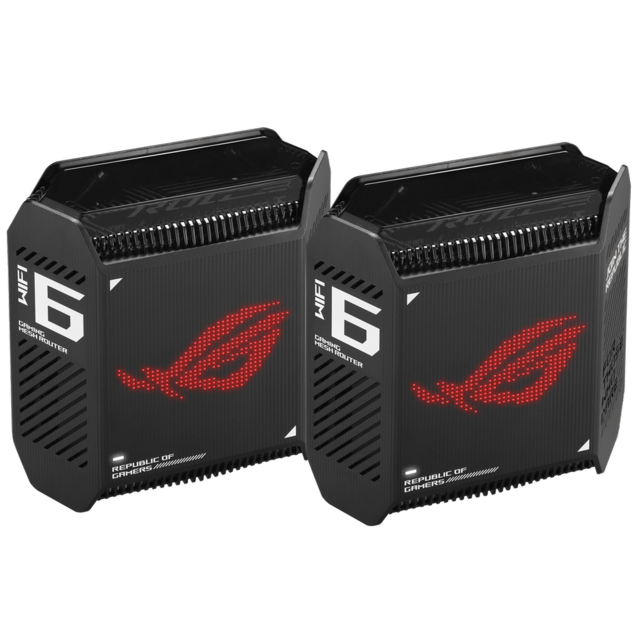
ASUS ROG Rapture GT6
Low latency makes it great for gaming
Generally, mesh Wi-Fi isn’t recommended for gaming, but ASUS ROG has gone a long way to make sure the ROG Rapture GT6’s hardware is up to the task with an AX10000 tri-band connection using newly available 5GHz for dual 160MHz bands without dipping into DFS spectrum.
- Fast tri-band AX10000 connection
- Low congestion at higher 5GHz frequencies
- Excellent expansion options with AiMesh
- No Wi-Fi 6E
- Quite expensive
A good online gaming experience is all about keeping ping as low as possible. Ping is the measure of latency between your device and the game servers, typically measured in milliseconds. Traditionally, mesh systems are not recommended as gaming routers because the extra mesh hops can add unpredictable latency, but ASUS has gone to great lengths to keep the ROG Rapture GT6 mesh kit running fast with low pings.
Something unique about the Rapture GT6 is that it uses a tri-band AX10000 connection with two 160MHz 5GHz bands. To do this, ASUS used the latest available spectrum to create a wide 5GHz band at around 5.9GHz. This allows ASUS to use a range that's likely to be vacant and avoid the power level limitations that come with 6GHz spectrum and Wi-Fi 6E.
The AX10000 speed breaks down to 574Mbps at 2.4GHz and 4804Mbps on both of the 5GHz bands. On the back of each node, there are three gigabit Ethernet ports and a single 2.5Gbps Ethernet port. That means you can get connected to a fast multi-gigabit internet connection with a wireless backhaul that can keep up. You can even place your GT6 node with your gaming setup to connect with a wire, further reducing potential congestion. Of course, your fast gaming devices like the ROG Phone 7 Ultimate can use 160MHz Wi-Fi for a 2402Mbps connection.
The look of the ROG Rapture GT6 won't be for everyone, with an industrial design and gamer aesthetic like RGB lighting. Even so, you can get them in white or black to match your home as much as possible. ASUS also allows you to expand your mesh using just about any ASUS router, including traditional ROG gaming routers. If you want the ability to game in every room of the house without giving up ROG gaming features, the GT6 could be worth the price.
Do you really need a mesh system?
While mesh Wi-Fi systems can be a great upgrade to your home network, they require you to buy and deploy multiple nodes. Mesh systems also need a bit of extra speed to account for the backhaul link between nodes, so the overall cost of your Wi-Fi system can be quite high. Still, using a single router means you could find yourself relying on the much slower 2.4GHz bands in some rooms of your house.
If you're using the router provided by your internet service provider, you may find the upgrade to one of the best Wi-Fi routers to be all you need. These routers have modern tech like MU-MIMO to improve connection quality to multiple devices at once. They may also have 1024-QAM and OFDMA, which allow the router to keep speeds high in areas with lots of congestion thanks to better, more precise modulation than older routers. And, of course, some of these routers, such as the models from ASUS, allow you to add mesh coverage later with compatible nodes, so you can expand as needed without giving up the advanced features more common on traditional routers.
Before purchasing, think about where your router is located. The wireless signals used by routers are able to penetrate multiple walls, but other things like furniture and appliances can cause extra degradation. If you've hidden your router behind a shelf or in a corner, it's worth checking to see if your coverage improves by placing the router up higher and, if possible, in a more central location in your home.
Get the right coverage and speed for your home
The best mesh for your home comes down to how much space you need to cover and the speed you need. If you're only interested in streaming video and browsing the web, one of the cheapest AX1800 Wi-Fi 6 mesh systems — the TP-Link Deco X20 three-piece kit.
While not strictly necessary for all people, a tri-band mesh system will be your best bet for consistently fast wireless speeds. The ZenWiFi XT9's AX7800 connection will have no trouble keeping pace with a gigabit connection. It's even ready for speeds greater than 1Gbps with a 2.5Gbps Ethernet port on every node. With AiMesh expansion, just about any Asus router can be added as a node, making finding the right node to expand as easy as possible.

ASUS ZenWiFi XT9
The Asus ZenWiFi XT9 is a tri-band mesh kit with up to AX7800 speeds. This allows for fast connections on both 5GHz bands, so you don't have to choose between a fast backhaul and fast device connections. There's a 2.5Gbps Ethernet port for multi-gig connections, and you get Asus' strong AiProtection Pro package included for free.
